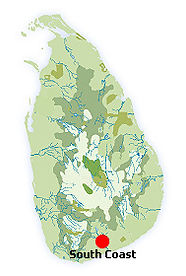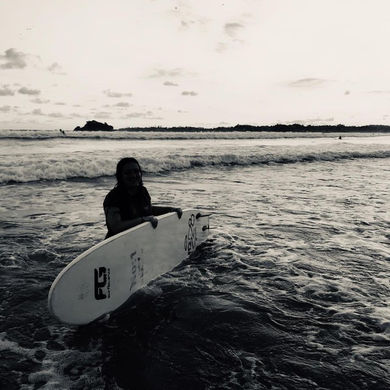WELIGAMA
Weligama (meaning ‘Sandy Village’) is an interesting blend of lively fishing town and beach resort. It is a picturesque fishing village renowned for its stilt fishermen. A predominate sighting in the sea for passers by, stilt fishermen practice a unique method of fishing where they balance on 50m poles in shallow water and cast their lines out to sea. Although Weligama is a quieter tourist destination with stretches of uninhabited beaches as of recent it has become a noted surf spot with a number of famous surfing points. Its close proximity to Mirissa makes it a good place at which to relax after a couple of hours spent whale watching on the high seas., you'll also find the sandy beach is attractive once you're away from the main section; there's a couple of cove beaches west of the centre. At the east end of the beach, there's an enormous new concrete Marriott hotel, which towers over the surrounding buildings and looks completely out of place.
Weligama's benign beach break is ideal for novice surfers and many independent travellers learn to ride their first waves here. After fun in the ocean you can marvel at (and feast on) the denizens of the deep, who end their days being hacked up and sold from roadside fish stalls.

Weligama Information and Google Map
PROVINCE : SOUTHERN PROVINCE
DISTRICT : MATARA DISTRICT
POPULAR : BEACH,SURFING,WATER ACTIVITIES
WEATHER : 31 °C
PHOTO GALLERY
Historical Background
The south coast is part of the ancient Ruhuna kingdom. In 1826, a British administrator, George Turnour, discovered palm-leaf manuscripts at Mulkirigala Temple containing the key to translating the Mahawamsa, or the ‘Great Chronicle.’ This enabled scholars worldwide to study the eventful history of the island from 543BC to comparatively modern times. Along the coast, stilt fisherman, cinnamon peelers and Beeralu lace weavers continue with their age-old traditions whilst alongside them villas and boutique hotels caters for tourists eager to escape the main holiday centres.
Shopping
Wayside stalls and village fairs offer a range of home grown vegetables, fruit and freshly-caught seafood. The towns of Matara and Tangalle are relatively well-developed coastal towns. Banks and ATM machines, shops and grocery stores are all available.
Events
The south coast's peak holiday season runs from late November to April. During this period the weather is generally at its best and this means blue seas. This is also the best season for diving and snorkelling. December and April are also the best months for seeing whales and dolphins (see activity section below).
Climate
Traditionally, the best time to visit the south coast is from December to April, with similar weather patterns to the Galle Coast. Between May and September, however, travel east beyond Galle along the south coast and you can be rewarded with more settled weather than further west. Sri Lanka is affected by two monsoons which generally means that there is good weather somewhere. October to mid-December can see heavy rain brought in by the north-east monsoon, with the south-west monsoon bringing heaviest downpours from mid-April to mid-June. There is also an unsettled inter-monsoonal period in October.
Sights
No beach is more magnificent than Mirissa, which is popular for surfing, snorkelling, scuba diving, deep-sea fishing, sailing and sea-kayaking. During the migration season in December and April, large pods of Dolphins and Blue Whales can be seen just a few miles offshore from Mirissa. Mirissa Water Sports, based in the Mirissa Harbour offers boat excursions which can take up to three hours.
At Ahangama, Midigama and Weligama, surfers prowl the shores in search of some of the best waves in Sri Lanka. Dondra Head, with its octagonal lighthouse, marks Sri Lanka's most southerly tip. Close-by, lie the beaches of Polhena and especially Talalla, a gorgeous beach that remains relatively unknown. Dickwella is known for its beaches and scuba diving. Dickwella’s Beeralu Lace Craft Village shows off hand woven Beeralu lace (pillow lace) which is a recognised national craft and a vital source of income for rural women of the south coast. Tangalle offers a glorious, uninterrupted stretch of beach. Seek-out the small and often deserted cove of Seenimodera (Sugar Bay).
The southern coast also serves as an ideal base to explore the south’s wildlife parks including Yala and Uda Walawe National Parks and Bundala.






